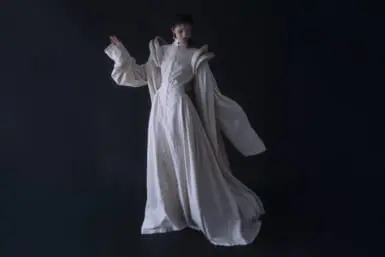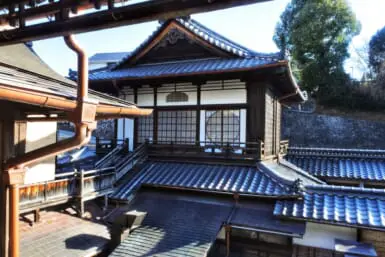What does it mean for an artwork to be authentic? David Stanley Hewett, who has spent his life studying traditional Japanese artistic techniques, has dedicated the better part of his extensive career to the pursuit of this elusive quality.
Now based in the tranquil, mountainous town of Karuizawa, Hewett arrived in Japan in the late 80s to study ceramics. He has since developed an original style of pottery, which is but one facet of his prolific oeuvre. He’s perhaps best known for the Bushido series: large-scale paintings featuring carefully applied Kanazawa gold leaf topped by dramatic, inky swooshes of thrown paint, inspired by a laborious study of history and traditional Japanese screen-making.
Hewett’s signature gilded canvases act as evocative bridges between antiquity and modernity in the various spaces they occupy: galleries around the world, luxury hotels, a Shinto shrine and even the National Archives in Washington, D.C.
In Search of Imperfection
Creativity has been integral to Hewett’s life and identity for as long as he can remember. In his youth, he developed a deep love for ceramics, which bloomed into an all-consuming passion after he attended a Japanese pottery show as a college student. “I thought it was the most beautiful thing I’d ever seen,” he recalls.
Hewett moved to Tokyo after graduating from the University of Massachusetts with a degree in Japanese history. He spent three and a half years training under a potter, teaching English on the side to support himself. Thus began a lifelong inquiry into the meticulous methods and refined artistic sensibility of Japanese craftsmanship.
An Enduring Craft Reimagined
A serendipitous encounter with Japanese byobu (traditional folding screens) at the Mitsui Memorial Museum in the early 2000s would alter the course of Hewett’s career. The screens on display, dating from the 12th to 14th centuries, were missing much of their original pigment, making their subject matter hard to distinguish. Yet, as Hewett recalls, their luminescent gold leaf backgrounds had remained intact.
“I looked at it not as an old piece of art that was falling apart,” he explains. Instead, he imagined it as a contemporary, abstract work. “I took it out of its context … and thought, Wow, this is an amazing opportunity for exploration.” For Hewett, that meant finding one of the country’s few remaining traditional screen-makers to train under. Staying true to Heian-era craftsmanship made the process of building each screen incredibly labor-intensive: Each one took him around six months. But it was important to him to honor the process.
Eventually, Hewett transitioned to working on canvas and wood. His work retains a deep connection to the original form; many of the pieces in the Bushido series are separated or segmented in a way that’s directly inspired by byobu screens. “In my abstract work, there are a lot of references to traditional themes,” he notes. “I’m pulling out themes in terms of subject matter, but also in terms of technique.”
As the series’ name implies, Hewett draws deep artistic inspiration from bushido, a moral code concerning samurai attitudes, behavior and lifestyle. When he first encountered this philosophy as an exchange student at Hokkaido University, it struck a deep chord with him, and it grew even more resonant after his experience in the United States Marine Corps. It’s a worldview he has come to understand on a personal level: One moment of adversity can reveal the result of decades of training and preparation.
This “moment of revelation,” as he calls it, is often literalized in the Bushido paintings by a splash of dark paint, thrown boldly across a gleaming, painstakingly realized gold leaf surface. There is, as Hewett notes, no room for error. As he marks the canvas with a decisive swing of his arm, the calligraphy brush in his hand resembles a sword.
The Pursuit of Authenticity
The artist’s strong connection with samurai culture stems from more than just intellectual curiosity. As a former infantry Marine and lifelong creative, Hewett feels drawn to the duality of samurai: In addition to being dedicated warriors, he explains, they also exerted a great deal of influence in cultural realms such as poetry, painting and tea ceremony.
Hewett’s works resonate deeply with his audience. Akie Abe, wife of the late Prime Minister Shinzo Abe, is among them; she selected the subtle yet compelling “Majime” as a gift to the first lady of the United States in 2017. Another of Hewett’s works can be found on the ceiling of Kumanokotai Shrine, a center of Shinto spirituality in Karuizawa.
Yet, when asked about his greatest accomplishment as an artist, Hewett says it’s still to come. “I think that achievements are fun, but they’re not the goal. For me, the goal is creating.”
Of course, he enjoys working on collaborative projects and commissions. Hewett’s paintings take center stage at some of Japan’s finest hotels, permanently displayed at The Imperial Hotel and The Peninsula Hotel in Tokyo, The Ritz-Carlton Tokyo and Kyoto and many more. And last year, he held a major joint exhibition with Living National Treasure Manji Inoue, a revered hakuji (white porcelain) potter, at Onishi Gallery in New York City.
More than his long list of accolades, however, Hewett values his well-earned credibility as an ambassador of Japanese history and craft. “I think the reason my work resonates with people so much is that I’ve done the work,” he says. “I was an apprentice to a potter. I went and learned how to make screens the traditional way. I went and learned how to do Nihonga Japanese painting.”
After a 32-year journey in Japan — amounting to more than half his life — Hewett still itches to learn and experiment. Each time he splashes the canvas, he can’t predict the exact outcome; it is the beauty in this exciting uncertainty that propels him to continue creating. “There’s an element of chance. Throwing the paint is embracing that and saying, ‘I’m going to do it anyway,’” he muses. “Even though there’s a risk, I’m going to do it anyway, because that’s what I’m here to do.”
More Info
David Stanley Hewett Studio & Gallery
3945 Nagakura, Karuizawa, Nagano 389-0111
Staff are available to guide you, but to ensure a personalized experience, an advance booking is recommended.





















